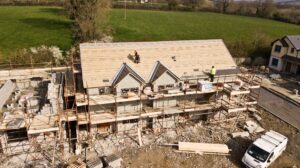Do I Need a Permit to Remove a Gas Fireplace
Over time, an interior design that was once new and fresh can become outdated. Whether renovating your entire home or a single room, you may need to remove a gas fireplace. When removing this type of fireplace, it’s possible to remove the insert or get rid of the entire unit. Depending on the team you hire and the scale of the project, your costs can range from $500 to $3,000.
Some of the expenses associated with a gas fireplace removal project center around the permits you may need to apply for. While some smaller renovation projects can be completed without a permit, most require one to make sure the work is done legally. If you remove a gas fireplace without a permit, you could face serious consequences, including everything from fines and project delays to tearing down your work. This guide answers the question “Do I need a permit to remove a gas fireplace?”.

Understanding Gas Fireplace Removal
There are plenty of reasons to remove a gas fireplace. If you’re looking to change your floor plan or get rid of a major system that requires ample maintenance, this project might appeal to you. Homeowners are also choosing to get rid of their gas fireplaces because of the negative impact they have on the environment. There are some factors to consider before you decide to remove your fireplace.
The process of removing a gas fireplace can be time-consuming. It’s best to hire a professional who can handle it more efficiently. This process begins by removing the insert, which is done after turning off the natural gas supply that’s sent to the unit. Your fireplace may be outfitted with a shutoff valve, which blocks gas from flowing into the system. If your fireplace doesn’t have a valve, the main gas supply may need to be turned off.
Once the gas has been turned off, the trim pieces along the top and sides of the insert can be taken out. The trim might be attached to the backing material with glue, screws, or nails. If it’s glued to the material, it may need to be removed with a pry bar. Some inserts have unique installations that place the trim behind the stucco or brick. In this scenario, your contractor will likely chip these items away to gain proper access to the trim pieces.
These inserts can also come with electrical wiring that helps with the ignition process. This wiring must be detached before the rest of the fireplace can be removed. When disconnecting an electrical line, your power should be turned off at the fuse box or breaker. You can use a circuit tester to verify that the wires are dead. The ends of any wires should be covered with electrical tape.
If your fireplace has grates or ceramic logs, they need to be removed before the insert is taken out. These items are often held in place with bolts, brackets, or screws. Pull them out to safely remove the items. Some gas fireplaces use venting systems that send the smoke outside an exterior wall. If you have venting in your home, it needs to be disconnected from the fireplace insert. You can also hire a professional to seal your chimney if you’re not replacing the system.

Once everything has been properly disconnected, you can remove the fireplace insert. Make sure a large cloth is placed below the fireplace to capture any dirt that dislodges from it. Some inserts can be heavy, which is why this process often needs to be performed by a professional. Before the main gas line is turned back on, it needs to be capped.
The main issue with attempting to remove a gas fireplace yourself is that it can be dangerous. There are numerous safety hazards associated with gas fireplace removal. If your fireplace is partially powered by electricity, you may need to remove the wires that are attached to the insert. Handling electrical wiring can be dangerous if you don’t know what you’re doing.
The logs and ceramic pieces that are often present in gas fireplace inserts can have sharp edges as well. If you’re not careful, you could cut yourself. You can avoid injuries by wearing protective gear, which includes the following:
- A dust mask that allows you to avoid inhaling fine particles
- Safety goggles to keep dust and debris away from your eyes
- Heavy-duty gloves that protect you from sharp edges
Exploring Permit Requirements
Building permits are issued by local municipalities based on city ordinances. State and federal governments don’t have permit standards, which is why building codes can differ from city to city. Contact your local building department to determine if you need to apply for a permit before removing your gas fireplace.
If you choose to hire a contractor to handle the project, they’ll know if a permit is needed. Your contractor might inform you that they already have the necessary documentation. Before the project begins, make sure you verify that the permit is in hand. You’re ultimately responsible for ensuring that the remodeling project is performed legally.
In California, most of the regulations about gas fireplaces revolve around the installation of these systems. For example, ventless natural gas fireplaces usually aren’t allowed in California. A permit is needed to remove a gas fireplace to ensure that your home is still up to code after the project is done. Since each city can have different permit requirements, you shouldn’t automatically assume that your project adheres to local guidelines.

Factors Influencing Permit Necessity
There are numerous factors that influence the need to obtain a permit. For example, local building codes and regulations vary from one city to the next. However, they are often similar. Most cities allow new countertops to be installed and walls to be painted without a permit. On the other hand, any work that alters the structure of your home requires a permit.
The structural changes involved in gas fireplace removal determine if you need a building permit. If you intend to remove the insert but wish to keep the rest of the system intact, you might be able to do the project without a permit. Make sure that you also consider how safe the project is and if it will harm the environment before applying. Analyzing these factors will allow you to identify if a permit is required.
Researching Permit Requirements
You can find out about the permit requirements in your area by contacting the local building authorities. They will have all the latest information and can inform you if changes have been made to the building codes. Consulting with licensed professionals will also allow you to get the information you need before you remove your gas fireplace. Permit expediters know how to navigate the approval process without experiencing delays. Most local building authorities also offer online resources that include permit information. If your project is set to occur in Los Angeles, visit the LADBS website to learn more about the permit requirements in your area.
Consequences of Proceeding Without a Permit
Removing a gas fireplace without a permit is illegal. If you make any structural changes to your home during the project, the integrity of the building can be damaged. You may also encounter safety hazards when dealing with gas and electricity. When you don’t comply with local building requirements, the city could assess large fines. They might also ask you to tear down any work you’ve done.
Steps to Obtain a Permit
Applying for a permit is a complex process that requires precise documentation. First, you may be tasked with creating a project plan, which outlines the scope of your project as well as its budget. Your building department will require all project details, which include any building plans and drawings you make.
Consider setting up a pre-application meeting with the building department. Local officials may inform you of potential issues during this meeting, which can save you a lot of time and money. It’s also a good idea to have a permit expediter by your side who can answer any questions you might have.
When submitting your application, you may need to pay some fees. The costs associated with a permit depend on the scope of the project. You can pay anywhere from $50-$2,000 for a building permit. An electrical permit may also be required, which comes with its own fees. Once you gather the necessary documentation and pay the fees, you can submit your application. The building department will then evaluate your plans and project details to make sure everything is up to code.
Conclusion
Building and electrical permits are regularly required when removing a gas fireplace. While your permit application should be approved without issue, it’s highly recommended that you hire a permit expediter who can help expedite the approval process and avoid delays. Adhering to permit requirements is essential before you remove your gas fireplace.
If you don’t submit the proper documents alongside the permit application, it could be denied. If you attempt to complete the project without requesting a permit, you might be fined by the city. Having non-permitted work in your home can also make it more difficult for you to sell your property in the future. If you’re considering gas fireplace removal, make sure that you adhere to all permit requirements and request help from professionals.

Jason Somers, President & Founder of Crest Real Estate
With over 15 years of professional experience in the Los Angeles luxury real estate market, Jason Somers has the background, judgement and track record to provide an unparalleled level of real estate services. His widespread knowledge helps clients identify and acquire income producing properties and value-ad development opportunities.
Learn more about Jason Somers or contact us.



